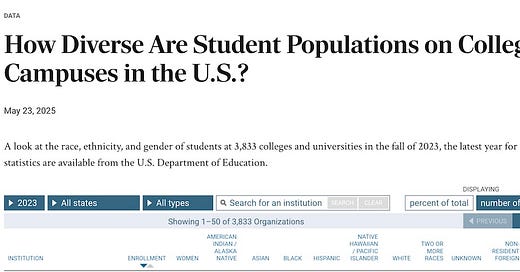Diversity in Christian Universities?
Or how I got sucked down a Chronicle of Higher Ed rabbit hole
My original plan for today’s newsletter was to address one of two newsworthy topics. I have wanted to do a deep dive on Republican arguments about their Medicaid reform proposals — not just because they’re immoral but also because I don’t think they’ll work. I have been reading Malcolm Foley’s The Anti-Greed Gospel and he makes the case about how the economic realities of chattel slavery precede racial structures, which has some direct parallels to the current immigration crackdowns.
But while reading my morning news updates in my inbox, I came across a piece in the Chronicle of Higher Education (paywalled) titled “How Diverse Are Student Populations on College Campuses in the US?” It has been released on May 23 but I had missed it before.
It’s not a story. It’s a searchable database of demographic breakdowns on 3,833 institutions ranging from career schools to R1 institutions using 2023 data (earlier years back to 2018 are available).
Got to admit, this was absolute catnip for a sociologist who studies Christian Universities. After realizing that I’d spent close to an hour sorting and resorting the data, I knew this had to be the focus of today’s SubStack.
Discussions of diversity, equity, and inclusion (DEI) have been roiling higher education for the last several years and have been basically shut down by the Trump 2.0 administration. But those conversations have been abstract. Looking at the actual makeup on colleges and universities helps provide needed context.
While Christian universities have not been attacked for DEI in the manner of high-profile institutions, they have been in the shadow of various state laws (which technically apply to public rather than private institutions). Additionally, as I argue in my book, demographic diversification might help Christian universities facing enrollment challenges.
I looked particularly at the percentage of the student body who were white, black, or female. What follows is a list of schools with the highest and lowest of each category along with some explanation. The data isn’t divided between undergraduate and graduate except for those schools that have spun off their non-traditional programs as a separate entity.
The Whitest Christian Universities
Mount Vernon Nazarene (88.5%)
College of the Ozarks (86.4%)
Evangel (85.7%)
Bryan (85.1%)
Northwestern — IA (84.2%)
Cedarville (83.7%)
Ozark Christian (83.5%)
Southwest Baptist (82.5%)
Indiana Wesleyan (82.2%)
Malone (81.9%)
Some of this reflects the demography of the region where the school resides (e.g., Northwestern). While I haven’t taken the trouble to cross-reference these instituions with their county demographics, some of these are in or near major metropolitan areas with considerable diversity.
The schools that are the least white? Fresno Pacific (24%) and Azusa Pacific (24.9%), both of which have large Hispanic populations. Belhaven comes in at 24% and over 50% of the population is Black.
Again, these schools might be understood to be reflecting the makeup of their surrounding area. On the other hand, there are many Christian universities in the South with pretty small numbers of Black students.
California Baptist has the largest Hispanic percentage at 42.9% based on its non-traditional programs. San Diego Christian is 36.8% Hispanic. On the other extreme, Missouri Baptist shows 0.5% Hispanic and Montreat is at 1.2%
Gender in Christian Universities
Most Christian liberal arts institutions skew female. Adding football and engineering and e-sports might help, but it’s an uphill battle.
Spring Arbor (76%)
Fresno Pacific (74.3%)
Roberts Wesleyan (71.2%)
Azusa Pacific (70.2%)
Colorado Christian (68.2%)
Southern Wesleyan (68.2%)
Seattle Pacific (68.0%)
MidAmerica Christian OK (67.5%)
Point Loma Nazarene (67.3)
Pepperdine (66.8%)
It’s possible that these percentages are elevated by graduate programs in female dominant fields. But it’s also quite likely to reflect somethign of the culture of the institution. Perhaps there is a particular recruiting strategy thay yields such results.
On the other hand, Erskine is 70.6% male. McPherson is 67.3% male. Only San Diego Christian and Oklahoma Wesleyan show a 50-50 gender split.
Foreign Students
Given the threats the Trump administration has raised over student visas, this seemed like one more data point to explore. Which Christian universities have the highest percentage of their enrollment from overseas?
Campbellsville has 35.4% of its student body as nonresident foreign students. They do have a very large non-traditional program and I don’t know how that factors in. Judson is the only other school over 20%. Even still, schools with substantive numbers of foreign students, like Southwestern Christian (16.4%) or Dallas Baptist (14.9%) could find themselves with major budget challenges if the foreign market dries up either through Trump administration action or by self-selection.
What Does All This Mean?
Honestly, I don’t know. In lots of ways my trip down the demographic rabbit hole left me with more questions than any firm conclusions. At the very least, it reminds us that Christian universities vary in considerable ways. Some may be large and play a central role in their surrounding area. Others may still be separating themselves from the larger culture. And, of course, Christian universities are often reflections of their feeder systems — churches, Christian schools, homeschool cooperatives, and camps — so it’s not surprising that they are generally less diverse that other segments of higher education.
I welcome your observations in the comment section below. And there will be no newsletter on Friday — I’ll be at the UMC Mountain Sky Annual Conference. Update is likely on Monday.





Is that Judson College, which closed a couple years ago? Or is there another Judson I’m unaware of?